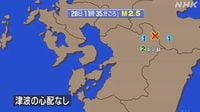On March 28, 2025, at 11:35 AM, a notable earthquake struck Minamiaso Village in Kumamoto Prefecture, registering a seismic intensity of 2. According to the Kumamoto Local Meteorological Observatory, the epicenter was located in the Aso region, approximately 10 kilometers deep, with an estimated magnitude of 2.5. This tremor was felt across the region, with Aso City reporting a seismic intensity of 1.
The Meteorological Agency provided detailed information about the earthquake, noting that the epicenter was positioned at 33.0 degrees north latitude and 131.2 degrees east longitude. In addition to Minamiaso Village and Aso City, tremors were also felt in Aso Ichinomiya, which is situated in Kumamoto, and Taketa City in Oita Prefecture. Both of these areas recorded a seismic intensity of 1.
Despite the earthquake's noticeable impact, officials have assured that there is no risk of a tsunami resulting from this seismic event. The lack of tsunami concern is a relief for residents, who often remain vigilant following any seismic activity.
This earthquake is part of the broader seismic activity that characterizes the Aso region, known for its active geological features. The area is home to one of Japan's most famous volcanoes, Mount Aso, which is a popular tourist destination. The geological setting makes it prone to earthquakes, and while this tremor was relatively minor, it serves as a reminder of the region's dynamic nature.
Local authorities have urged residents to remain prepared for potential aftershocks, which can occur following a seismic event. Preparedness is critical in earthquake-prone areas, where even minor tremors can lead to heightened anxiety among the population.
In recent years, Japan has implemented various measures to improve earthquake preparedness and response. These initiatives include regular earthquake drills in schools and communities, as well as the installation of advanced seismic monitoring equipment to provide real-time data during seismic events. Such measures aim to minimize the impact of earthquakes on communities and ensure public safety.
As part of ongoing efforts to enhance disaster response, the Kumamoto region has also focused on improving infrastructure resilience. This includes retrofitting buildings to withstand seismic forces and ensuring that emergency services are equipped to respond effectively during and after an earthquake.
Residents in the affected areas are encouraged to stay informed through local news and the Meteorological Agency's updates. Community engagement is vital, as sharing information and resources can help individuals better prepare for future seismic activity.
In conclusion, while the earthquake on March 28 was not severe, it highlights the importance of continued vigilance and preparedness in the Aso region. With its rich geological history, the area will likely experience more seismic activity in the future, making it essential for residents and officials alike to remain proactive in their disaster preparedness efforts.






